Armored Republic Body Armor 101

- What is Body Armor?
- How Does Body Armor Work?
- Is Body Armor Legal?
- Materials Used to Make Body Armor
- Materials Pros and Cons
- Protection Ratings and Standards
- How to Choose Armor
- What Size Armor Should I Get?
- Backface Deformation
- Fragmentation and Spalling
If you ever need a term defined, then visit our Armored Republic Body Armor Glossary.
What is Body Armor?

At its most basic, body armor is used to protect the wearer from physical attacks. Modern body armor is made from a variety of high-tech materials, the most famous being Kevlar®, which is a woven material that is layered to create ballistic panels used in “bulletproof” vests worn by military, civilians, and police around the world. But it’s incredibly important to note:
No body armor is bulletproof.
A truly bulletproof material would stop all bullets at all speeds at all quantities. No material fits that description. All materials designed to stop bullets are best described as bullet-resistant, specifically being resistant to the ammunition it was designed to defeat. But no body armor can guarantee to stop bullets of all velocities, weights, and designs.
With that in mind, certain bullet types will defeat certain types of armor more easily, and some exotic rounds may make a piece of armor much less effective. Armor manufacturing companies have to choose which bullets to prioritize stopping, and while they could potentially develop armor to stop truly exotic rounds, the priority is to protect the user from threats he/she is most likely to face.
The right to own and use body armor is protected in the Constitution under the right to bear arms - its only difference from firearms, as noted earlier, is that this equipment is designed to protect the wearer rather than to neutralize a threat through offensive engagement.
Are armor plates worth it?
Yes. Here are some reasons you could benefit from body armor:
- You work in the security field and need one for your job
- You work in a less desirable part of town and want added security
- You work in a gas station, convenience store, or another place open to the public at all hours
- You believe in being prepared and see body armor as a part of an overall safety and security plan
How Does Body Armor Work?
Body armor will stop a bullet in different ways depending on the material. All materials, however, will stop a threat by preventing penetration. The impact of the bullet is absorbed by the material and the bullet is either caught (as with soft armor), disintegrated (as with steel and, to a lesser extent, ceramic), or captured within the armor (as with polyethylene).
For more information, see the later sections about the aftermath of a bullet’s impact:
Is Body Armor Legal?
As body armor is often associated with firearms, it's common to have questions about regulations on the purchase or ownership of body armor, such as:
- Is body armor legal?
- Do I need a license to own body armor?
- How do I buy body armor?
While there have been several attempts to regulate body armor, all federal legislation has failed. So, unless you're a convicted felon, it's currently legal to own body armor in most of the United States- no license is necessary.
The only exception is Connecticut and New York. Residents in either state must be active law enforcement or military and provide necessary credentials or need to have items shipped out of state.
What Materials Are Used to Make Body Armor?
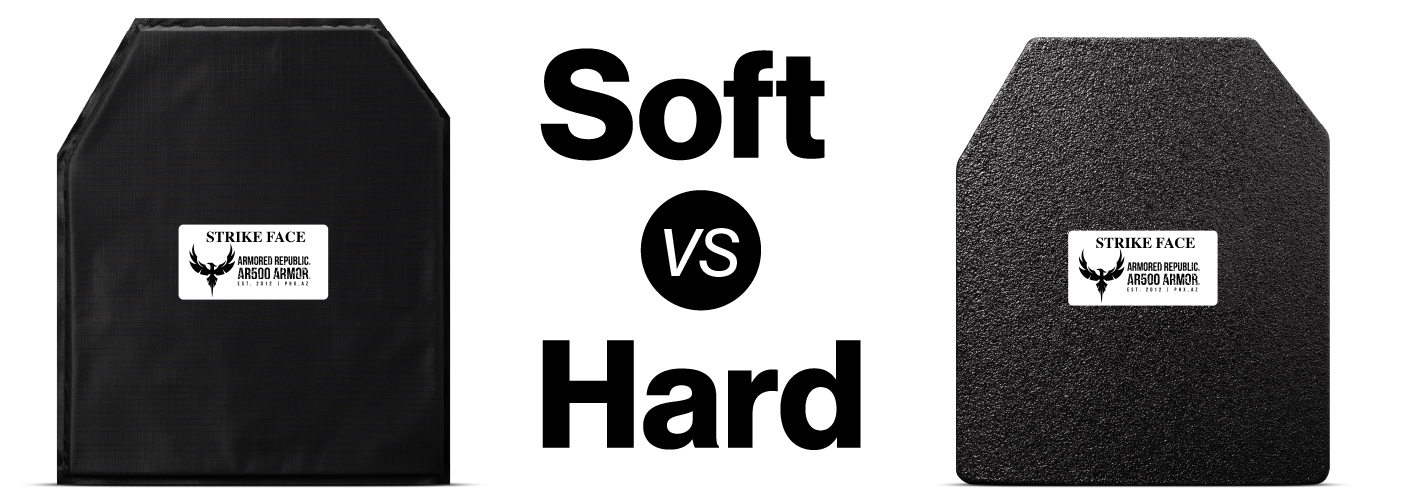
There are two general types of body armor, and several different materials used to make it:
- Soft armor, used in “bulletproof” vests (remember, though, that no armor is truly bulletproof), can be made from a P-Aramid material (such as DuPont Kevlar®, Teijin Twaron®), a Polyethylene material (such DSM’s Dyneema® or Honeywell Spectra®), or a combination of the two. These materials are then formed into a fabric that is cut and sewn to create the armor panels used in ballistic vests. Soft armor offers lightweight, flexible, and concealable protection against most handgun ammunition.
- Hard armor can be made from Armor-Grade Steel (such as AR500, AR550, and AR600), Steel Alloy armor blends, Ultra-High Molecular Weight Polyethylene (UHMWPE, also called polyethylene or PE plates), Ceramic Composites (such as aluminum oxide, boron carbide, or silica carbide), or a combination of these materials (such as ceramic paired with UHMWPE). Hard armor protects the wearer from both pistol and rifle-level threats.
Both types are worn in our plate carriers. The carriers themselves do not provide any protection against bullets.
Materials Pros and Cons
The variety and type of materials used in body armor offer a wide range of protection, price point, and profile (weight/thickness) combinations from which to choose. Some questions we receive from customers wondering which armor to choose are:
- What are the pros and cons of the armor materials?
- What are the differences between the types of armor?
- Why would I want to buy steel armor?
As with everything body armor, each type of material has its pros and cons.

Soft Body Armor
(Armored Republic's S Series)
Learn more about the Pros and Cons of Soft Armor.
Pros
- Thin
- Flexible
- Lightweight
- Concealable
Cons
- Only stops pistol & shotgun rounds
- 5-year shelf life
- More expensive when getting into the super lightweight and exotic hybrid materials

Alloy Body Armor
(Armored Republic's A Series)
Learn more about the Pros and Cons of Alloy Armor.
Pros
- Edge-to-edge protection
- Stops M855 'green tip' and similar
- Affordable
- 20-year shelf life
- Minimal backface deformation
- FragLock™ protective coating
- Thin
- Multi-hit capable
Cons
- Heavy
- Bare steel prone to bullet fragmentation
- Ineffective against armor-piercing ammo

Polyethylene Body Armor
(Armored Republic's P Series)
Learn more about the Pros and Cons of Polyethylene Armor.
Pros
- Lightweight
- Buoyant
- Stops M193 and similar high-velocity ammunition
- Multi-hit capable
Cons
- Expensive
- Thick
- 5-year shelf life in ideal conditions
- Can lose performance if exposed to high heat for too long
- Ineffective against “green tip”, armor-piercing, or similar ammunition
- No edge-to-edge protection: testing protocol allows for up to 2” edge failure

Ceramic Body Armor
(Armored Republic's C Series)
Learn more about the Pros and Cons of Ceramic Armor.
Pros
- Effective against the most powerful rounds
- Thin
- Less expensive than PE
- Can be multi-hit capable
- Lighter than steel
Cons
- More expensive than steel
- Prone to cracks or breaks if not stored correctly, reducing protection. Should be annually inspected/X-rayed
- 5-year shelf life
- No edge-to-edge protection: testing protocol allows for up to 2” edge failure
- Level IV test protocol only requires it to stop 1 round
- Heavier than polyethylene
Learn more about Armored Republic's Body Armor Matrix.
Protection Ratings and Standards
Most armor is advertised as a specific “Level” such as Level III, IIIA, or III+, for example. These are armor ratings based on the National Institute of Justice’s official performance standard, known as NIJ 0101.06. Questions often asked about these ratings are:
- How is armor rated?
- How do you know what it will protect against?
- What will a Level III or IV plate stop?
- What are the different armor protection levels?
- What is the highest level of body armor?
This section will address those questions.
Body Armor Protection Standards
The Department of Justice’s National Institute of Justice created the first performance standard for bullet-resistant police body armor in 1972. A few years later, they established ballistic certification- the current standard for which is known as NIJ 0101.06.
In order to classify armor’s ability to stop various projectiles, armor is given numeric ratings based on the standards. Each standard stops certain bullets at certain speeds, with higher ratings (such as Level IV, the highest) stopping the most powerful bullets.
Learn more about NIJ Standards.
Body Armor Protection Levels
Below is an overview of the NIJ’s standards for which ratings must stop which bullets. For a downloadable PDF document with more details on threat levels and the technical details about the testing protocols, see Justice Technology Information Center’s “Understanding NIJ 0101.06 Armor Protection Levels”
For all these ratings, it’s important to note that the NIJ testing protocol does not certify for protection within two inches away from the edge. Rather, the standard requires that all test shots are two inches or more away from the edge. With that said, a 10”x12” plate is really only certified to stop bullets within an 8”x10” range.
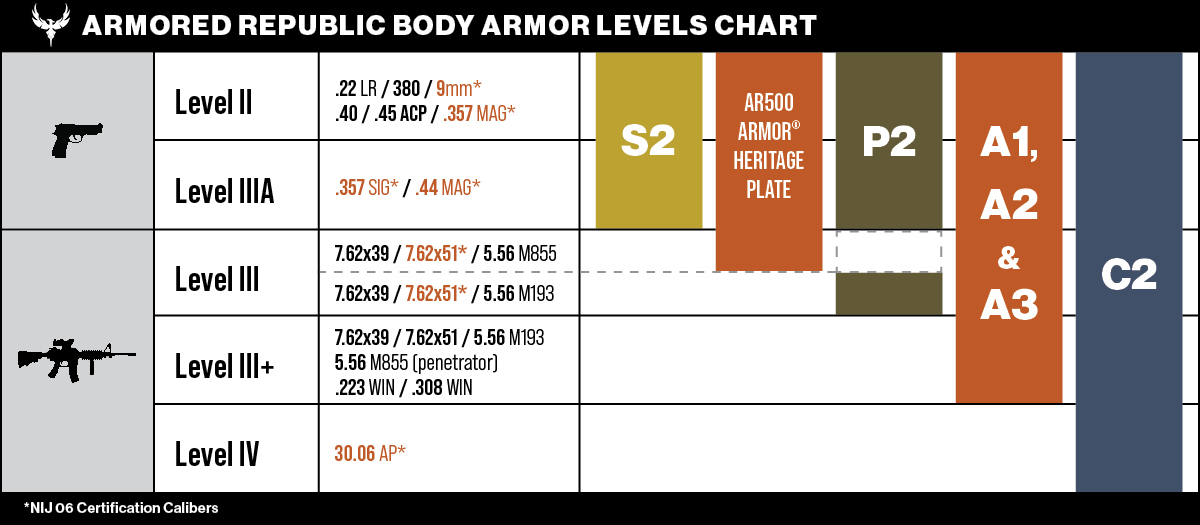
Will Level III plates protect me from lesser threats?
For Level II through Level III, the armor panel or plate also protects against the threats in the categories below it because they're all tested to the same standard, six rounds of the test ammunition.
For example, a Level IIIA vest will also protect against Level II, IIA, and I ballistic threats. Similarly, an armor Level III plate will stop lesser threats from the Levels II - IIIA standards.
Level IV plates are tested to a different standard: Only one shot of armor-piercing ammo. For that reason, the Level IV plate is not to be understood as simply an even stronger Level III, but rather a special threat plate intended to stop one especially powerful bullet. Of course, a Level IV plate will still protect you against one round of a lesser threat, but it is not rated to protect against multiple hits.
What factors determine a bullet’s ability to penetrate armor?
Armor is tested to defeat specific combinations of bullet caliber, weight, design, and velocity. These factors are what determine a bullet’s penetrating ability, and of these, velocity is most significant to an armor’s performance: A plate that can stop a bullet at 2,900 feet per second may fail to stop that same projectile at 3,100 feet per second. With that said, one way of comparing weaker plates to stronger plates is their ability to stop projectiles at faster speeds.
Factors that affect a bullet’s velocity include:
- The projectile mass (weight) and design
- The type, amount, and quality of the gunpowder used
- Barrel length
- Weather and atmospheric elements such as temperature, barometric pressure, altitude, and wind
How to Choose Armor
Choosing armor consists in choosing between different trade-offs; deciding to trade increased levels of protection for less cost, lighter weight, easier transportation, etc.
Recall the situation mentioned at the beginning of the article of addressing an active threat. In that scenario, you’d likely prefer to be wearing the most protective armor on the market (why would you want anything less?). However, always wearing the most protective armor possible may be outweighed by the drawbacks of it being expensive to buy and less comfortable to wear for extended periods of time. A compromise with potentially less protection but enough to safely cover most threats you’re likely to face may be a better choice.
With that said, here are some factors to consider:
- Do you expect to encounter pistol or rifle rounds? If you’re looking to protect against stray bullets when you’re hunting, plates able to protect against rifle shots would be ideal. If you’re working at a gas station, looking for increased levels of protection from an armed robber, a pistol-rated plate may be sufficient.
- Do you need your armor to be concealable? Hard armor is much more difficult to conceal than soft armor, so a soft armor option may be best for you in this case.
- Do you need armor that won’t fatigue you to wear? If you’re looking to wear your armor for extended periods, a lighter-weight option may be better for you.
- Is there a particular (or special) round that is common in your area? Are criminals using AK rifles, etc.?
- Do you need a multi-hit plate? Are you expecting longer engagements or a ‘one-off’ or errant bullet, say at a public shooting area or range?
- Do you need a plate that floats in water? Are you planning to have this on a boat or around lakes, streams, or rivers?
- How much can you spend? More expensive plates allow you to make fewer compromises on the features you want.
Once you’ve considered these questions, you should have a decent idea of what material and protection level you’d like.
Learn about Armored Republic's Body Armor Matrix and its four categories of armor:
- S Series: Soft Body Armor
- P Series: Polyethylene Body Armor
- A Series: Alloy Body Armor
- C Series: Ceramic Body Armor
The next matter is what armor size is best for you, and how you should wear it.
What Size Armor Should I Get?
Wearing the Right Size
The right size will make your armor protect you better and make it more comfortable to wear. With that said, here is how you can ensure you have the best fit possible for both your armor plates and your carrier.
One method of sizing armor is to base it off your height and t-shirt size, as laid out here:
- If your height is 4’5” to 5’3”: We recommend wearing 9”x9” plates in conjunction with our AR Freeman carrier. The Freeman will fit a range of users who wear an Adult Male T-Shirt Size: Small to X-Large.
- If your height is 5’4” to 6’3”: We recommend 10”x12” plates or soft panels, with any of our carriers slated to hold the same size plates.
- If you are 6’4” or taller: We recommend 11”x14” plates or soft armor panels. Our Testudo carrier houses 11"x14" plates.
Read: Which Plate Carrier Should I Get?
Another method to size armor is to take measurements and choose the plate or panel closest in size:
- Width: Measure across your chest from nipple-to-nipple
- Length: Locate the notch at the bottom of your throat, at the top of your sternum. Measure from that sternal notch to your belly button, then subtract 2” (to allow for clearance when sitting)
Additionally, not all carriers will fit all armor; find the corresponding carriers for your choice armor in this list:
- 9”x9” plates: Available in steel only, these are an exclusive design for use as part of our Freeman loadout.
- 10”x12” plates and soft armor: These standard size plates are available in steel, ceramic, and UHMWPE, and will fit into the following carriers:
- Testudo: t-shirt sizes medium - XXL
- Valkyrie: t-shirt sizes medium - XXL
- AR Invictus: t-shirt sizes medium - XXL
- AR Concealment, standard: designed for 10”x12” soft armor panels, for users wearing t-shirt sizes
- 11”x14” plates and soft armor: These large plates are available in steel only.
- Testudo: t-shirt sizes medium - XXXL
- AR Concealment Carrier, Large: designed for 11”x14” soft armor panels, for users wearing t-shirt size.
How Do I Wear My Body Armor?
These steps lay out how to properly fit your armor and carrier:
- Insert your armor plates into the carrier.
- Remove shoulder pads then loosen the shoulder straps (but don't undo them completely)
- Loosen the waist straps/cummerbund, then put the carrier on.
- Place the top of the plate carrier at the sternal notch (the notch at the bottom of your throat, at the top of your breastbone). Adjust the shoulder straps so the front and rear carriers are the same height.
- Adjust the waist straps or cummerbund for a snug fit
- Secure the shoulder straps and reattach the shoulder pads
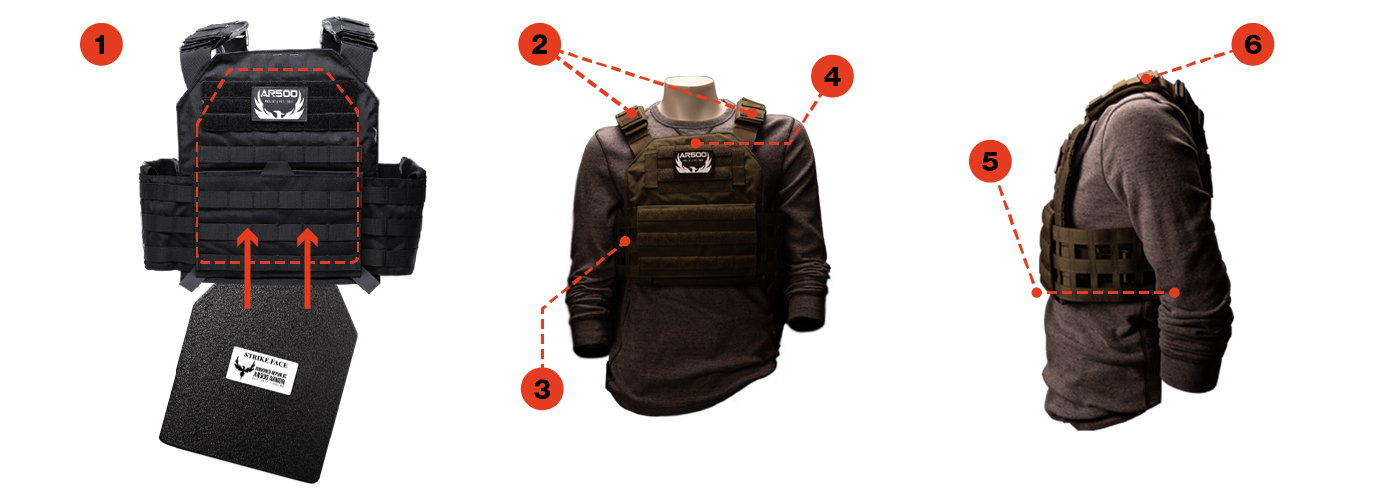
Helpful Video Resource: How to Wear a Plate Carrier & Body Armor
Backface Deformation

Body armor protects the wearer from the most devastating part of a bullet’s impact, but by itself won’t prevent injury completely; the blunt impact of the bullet can at times still cause injury, mostly due to what is known as backface deformation. This section will address a few questions on that topic, such as:
- What is backface deformation and why should I worry about it?
- Is backface deformation dangerous?
- What is blunt force trauma?
- What are trauma pads?
Energy Transfer
When a bullet hits armor of any kind, it carries energy. Heavier and faster bullets transfer more energy, but no matter the amount, that energy must go somewhere. Different types of armor will receive that energy and react in different ways.
Soft armor is designed to ‘catch’ the bullet to stop it, which takes time and distance. As the vest stops the bullet, the vest is deformed in the direction of the projectile’s travel toward the wearer’s body. The distance the armor deforms is commonly called “backface deformation” or “backface signature.” How much the armor is deformed depends on the protective level of the vest and how much energy the bullet transfers.
Hard armor is affected by the bullet's energy transfer as well, but in different ways: While steel armor shatters and redirects the projectile, polyethylene plates and ceramic plates absorb the bullets and can have backface deformation.
Backface deformation often results in bruises, broken bones, contusions, and other injuries, which are sometimes referred to as blunt force trauma. That begs the question:
How do you prevent backface deformation injuries?
There are two ways to mitigate backface deformation in soft armor: Wearing thicker vests or using trauma pads. Thicker vests, however, can add weight and significant cost to a ballistic vest.
For hard armor, wearing trauma pads or a layer of soft armor behind the plate can also attenuate the backface deformation.
Trauma pads are pads that, while not bullet resistant, are quite useful for decreasing and distributing a bullet’s energy beyond what the vest or armor plate can do by itself. They are worn in your carrier behind the armor.
For more information on backface deformation, check out our YouTube channel, where we have several examples of different levels of backface deformation.
Fragmentation and Spalling

When a bullet hits a hard armor plate, both the bullet and the plate have the potential to break - in fact, most bullets break when stopped by hard armor. Those broken pieces have some significance to how we understand armor’s function, which this section will address to answer questions such as:
- What are frag and spall?
- How do you protect against bullet frag?
- Do steel plates spall?
- How do you prevent bullet fragmentation?
Fragmentation and spalling are two terms that refer to these broken pieces: The bullet’s broken pieces are called fragmentation while pieces of the plate are called spalling. They are technically different but often used interchangeably.
Fragmentation and spalling can occur with any plate, but steel plates appear to have these things more often.
Read more on NIJ's Standards Regarding Fragmentation.
Preventing or Reducing Fragmentation
When a bullet hits a plate of steel armor rated to stop it, the bullet will disintegrate, sending bullet fragments in a 360º pattern perpendicular to the plate’s strike face. If this is what causes dust to rise around a target after it’s been shot; the ground was hit with a scattering of bullet fragments.
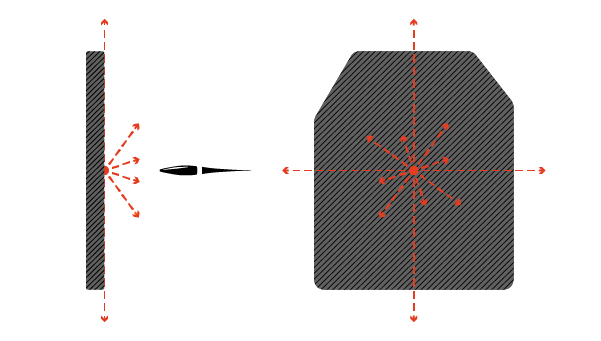
We want to reduce fragmentation from bullets shot into our armor to prevent those fragments from flying into our bodies where we are unprotected.
-
To reduce the amount of fragmentation, Armored Republic uses FragLock™ coating on all our ballistic steel plates. FragLock is a proprietary polyurea seal that helps redirect or capture bullet fragments, depending on whether it’s the base coat or build-up coat. This seal also protects the plates against damage from harsh environments.
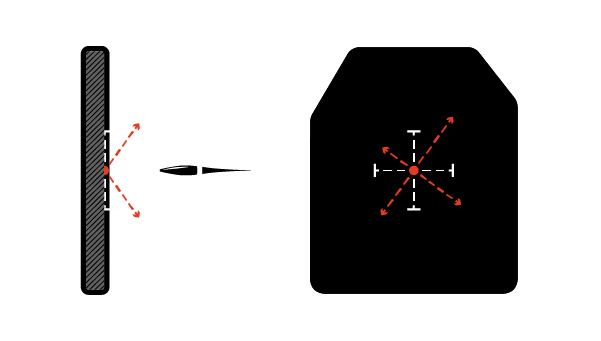
The base coat, which all our Steel plates come with by default, is a foundational FragLock seal that protects from some fragmentation, primarily by helping redirect it away from the wearer.
-
Our build-up coat is an even thicker layer of FragLock and is designed to capture most or all fragmentation.
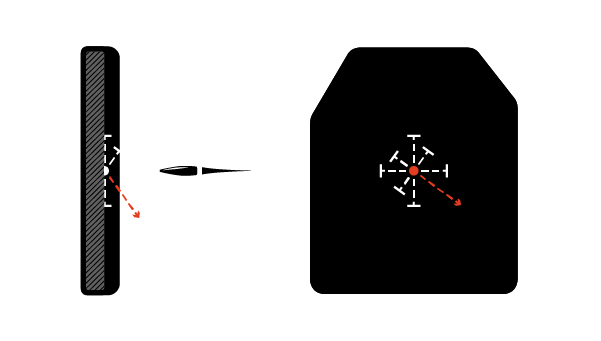
-
For more articles and videos about FragLock and its mitigation properties, visit our Armored Republic FragLock Fragmentation Coating page.
Conclusion
Different situations will be best suited by different loadouts, featuring different carriers and plates. But ultimately, if you need to address an active threat to yourself or others, the best armor is the armor you have with you: Don’t get caught without protection when you need it. Check out your options by looking at our body armor or carrier pages.
The armor industry is constantly evolving and Armored Republic is always looking to be at the forefront of that progress. Follow us on Facebook and Instagram for more information and current news. Also, check out our Youtube channel and the rest of our Knowledge Base to stay up-to-date on the latest educational content regarding body armor.
